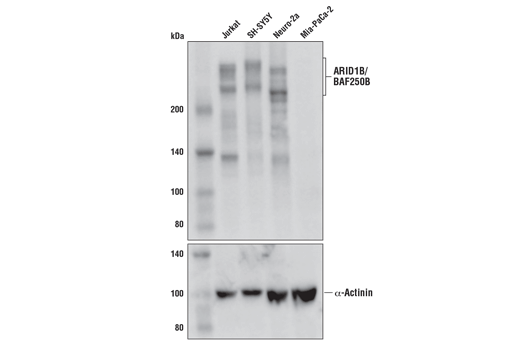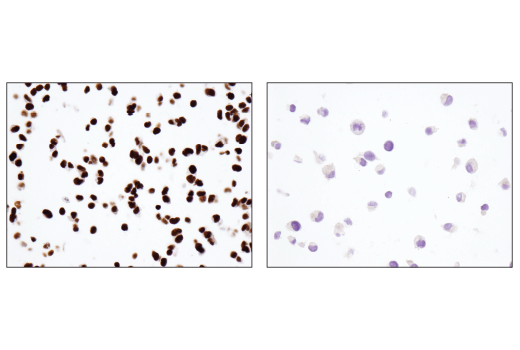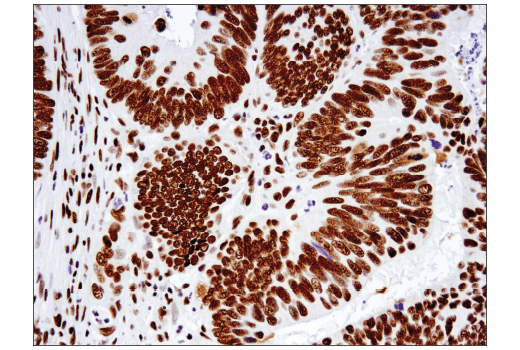WB, IP, IHC-P
H M
Endogenous
250, 280
Rabbit IgG
#Q8NFD5
57492
Product Information
Product Usage Information
| Application | Dilution |
|---|---|
| Western Blotting | 1:1000 |
| Immunoprecipitation | 1:100 |
| Immunohistochemistry (Paraffin) | 1:500 |
Storage
Specificity / Sensitivity
Species Reactivity:
Human, Mouse
Source / Purification
Monoclonal antibody is produced by immunizing animals with a synthetic peptide corresponding to residues surrounding Ala1320 of human ARID1B/BAF250B protein.
Background
ATP-dependent chromatin remodeling complexes play an essential role in the regulation of nuclear processes such as transcription and DNA replication and repair (1,2). The SWI/SNF chromatin remodeling complex consists of more than 10 subunits and contains a single molecule of either BRM or BRG1 as the ATPase catalytic subunit. The activity of the ATPase subunit disrupts histone-DNA contacts and changes the accessibility of crucial regulatory elements to the chromatin. The additional core and accessory subunits play a scaffolding role to maintain stability and provide surfaces for interaction with various transcription factors and chromatin (2-5). The interactions between SWI/SNF subunits and transcription factors, such as nuclear receptors, p53, Rb, BRCA1, and MyoD, facilitate recruitment of the complex to target genes for regulation of gene activation, cell growth, cell cycle, and differentiation processes (1,6-9).
ARID1B (A-T rich interacting domain 1B), also known as BAF250B, is a DNA-binding member of the SWI/SNF complex. It has 60% homology with ARID1A/BAF250A, and the proteins are mutually exclusive members of the complex, akin to Brg1 and BRM (10). ARID1B plays a role in synapse formation and dendritic arborization in neuronal development, and haploinsufficiency of ARID1B has been reported in intellectual disability (11-13). Mutations in ARID1B have also been shown in Coffin-Siris syndrome (14). ARID1B/BAF250B is a critical vulnerability in ARID1A/BAF250A mutant cancers, and could be explored as a potential therapeutic target (15).
- Ho, L. and Crabtree, G.R. (2010) Nature 463, 474-84.
- Becker, P.B. and Hörz, W. (2002) Annu Rev Biochem 71, 247-73.
- Eberharter, A. and Becker, P.B. (2004) J Cell Sci 117, 3707-11.
- Bowman, G.D. (2010) Curr Opin Struct Biol 20, 73-81.
- Gangaraju, V.K. and Bartholomew, B. (2007) Mutat Res 618, 3-17.
- Lessard, J.A. and Crabtree, G.R. (2010) Annu Rev Cell Dev Biol 26, 503-32.
- Morettini, S. et al. (2008) Front Biosci 13, 5522-32.
- Wolf, I.M. et al. (2008) J Cell Biochem 104, 1580-6.
- Simone, C. (2006) J Cell Physiol 207, 309-14.
- Wang, X. et al. (2004) Biochem J 383, 319-25.
- Ka, M. et al. (2016) J Neurosci 36, 2723-42.
- Halgren, C. et al. (2012) Clin Genet 82, 248-55.
- Hoyer, J. et al. (2012) Am J Hum Genet 90, 565-72.
- Tsurusaki, Y. et al. (2012) Nat Genet 44, 376-8.
- Helming, K.C. et al. (2014) Nat Med 20, 251-4.
Species Reactivity
Species reactivity is determined by testing in at least one approved application (e.g., western blot).
Western Blot Buffer
IMPORTANT: For western blots, incubate membrane with diluted primary antibody in 5% w/v nonfat dry milk, 1X TBS, 0.1% Tween® 20 at 4°C with gentle shaking, overnight.
Applications Key
WB: Western Blotting IP: Immunoprecipitation IHC-P: Immunohistochemistry (Paraffin)
Cross-Reactivity Key
H: human M: mouse R: rat Hm: hamster Mk: monkey Vir: virus Mi: mink C: chicken Dm: D. melanogaster X: Xenopus Z: zebrafish B: bovine Dg: dog Pg: pig Sc: S. cerevisiae Ce: C. elegans Hr: horse GP: Guinea Pig Rab: rabbit All: all species expected
Trademarks and Patents
使用に関する制限
法的な権限を与えられたCSTの担当者が署名した書面によって別途明示的に合意された場合を除き、 CST、その関連会社または代理店が提供する製品には以下の条件が適用されます。お客様が定める条件でここに定められた条件に含まれるものを超えるもの、 または、ここに定められた条件と異なるものは、法的な権限を与えられたCSTの担当者が別途書面にて受諾した場合を除き、拒絶され、 いかなる効力も効果も有しません。
研究専用 (For Research Use Only) またはこれに類似する表示がされた製品は、 いかなる目的についても FDA または外国もしくは国内のその他の規制機関により承認、認可または許可を受けていません。 お客様は製品を診断もしくは治療目的で使用してはならず、また、製品に表示された内容に違反する方法で使用してはなりません。 CST が販売または使用許諾する製品は、エンドユーザーであるお客様に対し、使途を研究および開発のみに限定して提供されるものです。 診断、予防もしくは治療目的で製品を使用することまたは製品を再販売 (単独であるか他の製品等の一部であるかを問いません) もしくはその他の商業的利用の目的で購入することについては、CST から別途許諾を得る必要があります。 お客様は以下の事項を遵守しなければなりません。(a) CST の製品 (単独であるか他の資材と一緒であるかを問いません) を販売、使用許諾、貸与、寄付もしくはその他の態様で第三者に譲渡したり使用させたりしてはなりません。また、商用の製品を製造するために CST の製品を使用してはなりません。(b) 複製、改変、リバースエンジニアリング、逆コンパイル、 分解または他の方法により製品の構造または技術を解明しようとしてはなりません。また、 CST の製品またはサービスと競合する製品またはサービスを開発する目的で CST の製品を使用してはなりません。(c) CST の製品の商標、商号、ロゴ、特許または著作権に関する通知または表示を除去したり改変したりしてはなりません。(d) CST の製品をCST 製品販売条件(CST’s Product Terms of Sale) および該当する書面のみに従って使用しなければなりません。(e) CST の製品に関連してお客様が使用する第三者の製品またはサービスに関する使用許諾条件、 サービス提供条件またはこれに類する合意事項を遵守しなければなりません。






